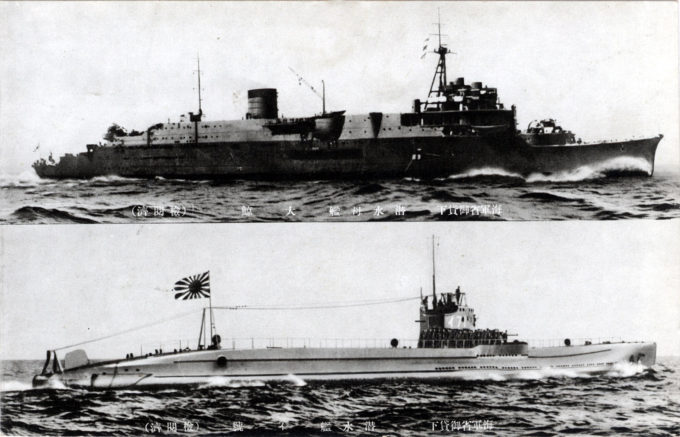
Taigei (top), as originally launched in 1933 as a submarine depot ship, and the I-71, a Kadai-VI-class submarine, completed in 1934, are both portrayed on this c. 1935 postcard. I-71 would participate in both the Pearl Harbor and Midway Island attacks.Taigei would undergo a conversion into an aircraft carrier (Ryuho) in 1941 but spent most of the Pacific War tasked with ferrying aircraft and pilots to Japan’s South Pacific bases.
See also:
Jingei-class submarine tender & Type-B1 and Type-C submarines
Imperial Japanese Navy aircraft carrier Akagi, c. 1930
I-71 service history
“The Kaidai-type submarine (shortened from Kaigun-shiki Ōgata Sensuikan, ‘Navy Large-Type Submarine’) was a type of 1st-class submarine operated by the Imperial Japanese Navy (IJN) before and during World War II. Seven variants were constructed between 1921-1943. Eight Kaidai VIs were constructed between 1934-1938; I-71 was constructed at the Kawasaki Shipyard, Kobe, and completed in 1934.
“At 23 knots, the Kadai VI had the fastest surface speed for any submarine at the time of construction, although the speed was bettered slightly by later Japanese submarines. Kaidai VIs contributed to the sinking of two American aircraft carriers during World War II. (The destruction of these submarines also hold some milestones: Sister-ship I-70 was Japan’s first major warship casualty in World War II, and the sinking of I-73 represented the first warship kill by a United States Navy submarine in the war.)
“Leading up to and including the Japanese attack on Pearl Harbor, I-71 was assigned to reconnoiter south of Oahu, and to attack any ships trying to sortie from Pearl Harbor. During this mission, I-71 was subjected to several depth-charge attacks, while also being credited with sinking the USS General Royal T. Frank, a U.S. Army transport ship off Maui’s Hana Coast, but returned to its base at Kwajalein unscathed in January 1942. I-71 (renumber I-171 in May 1942) was also a participant in the June 1942 attack on Midway, serving as a radio beacon for patrolling Kawanishi H8K ‘Emily’ flying boats patrolling east of French Frigate Shoals.
“On 5 February 1944 USN codebreakers intercepted and decrypted a message that read: ‘I-171 departed Rabaul January 30th to engage in transportation operations to Buka but she had not arrived at Buka by February 5th at 1800 as scheduled. After 3rd, she was called a number of times but there is no response. We have no further information on her …’ I-171 was presumed lost with all 91 hands off Buka, and stricken from the IJN rolls in March 1944.”
– Wikipedia
Taigei, and its conversion into the aircraft carrier Ryuho
“The London Naval Treaty of 1930 imposed limitations on new construction of major capital warships for the major world powers. The Imperial Japanese Navy responded in part by the construction of auxiliary vessels, such as fleet oilers and submarine tenders, designed so that they could be converted quickly into aircraft carriers in time of conflict. Taigei was ordered as part of the 1st Naval Armaments Supplement Programme of 1932.
“Although Taigei was designed from the onset for possible later conversion to an aircraft carrier, the design proved to have many shortcomings. Taigei was laid down at Yokosuka Naval Arsenal on 12 April 1933, and was launched on 16 November 1933. Formally commissioned on 31 March 1934, Taigei was soon damaged by a typhoon in what was later called the ‘Fourth Fleet Incident’. Seawater ingression from faulty waterproof doors shorted the electric system, disabling her steering and the waves from the typhoon cracked a number of the welds in her hull. Further repairs at Yokosuka Naval Arsenal were scheduled for early 1936, but were delayed by the ‘February 26 Incident’. It was not until September 1938 that Taigei was deemed fully operational, and assigned to its design role as flagship of a submarine squadron.
“Shortly before the start of hostilities in the Pacific War, Taigei was ordered back to Japan for its conversion into the light aircraft carrier Ryuho beginning on 20 December 1941 at Yokosuka Naval Arsenal. Conversion was to be completed within three months; however, numerous problems and issues arose, and the conversion work was not completed until 30 November 1942. In the meantime, Ryuho gained the distinction of being the only major warship damaged in the Doolittle Raid on 18 April 1942.
“Ryūhō was officially assigned to the IJN 3rd Fleet in December 1942, tasked primarily with ferrying aircraft and pilots to Japan’s South Pacific bases. Struck, on her first duty, Hachijojima by a single torpedo Ryuho was forced to return to Yokosuka for emergency repairs, and remained out of operation until early 1943.
“After a series of uneventful patrols and training missions between Japan and Formosa, Ryūhō was attacked by Task Force 58 aircraft on 19 March near Kure. The damage was severe: the flight deck bulged upward between the two elevators, the No. 1 boiler was punctured by a bomb fragment, the stern settled two meters into the water, and a raging fire broke out. There were 50 casualties, including 20 dead.
“Upon returning to Kure on 1 April, Ryūhō was considered to be a total loss. Moored as an abandoned hulk off of Etajima, Ryūhō was attacked by USN aircraft again on 24 July and 28 July. She was struck from the navy list on 30 November 1945, and was scrapped in 1946.”
– (em>Wikipedia

